It is nice to be finally home on a weekend and able to do whatever I want… (or at least what ever Isabelle will let me do). This weekend I continue working with the alpaca fibers by spinning them and plying them. Here are the related previous posts:
- Weekend with a Llama (Inky Dinky Do… actually an Alpaca)
- Avocado Dye and Inky Dinky Do
- Weekend Carding Alpaca (Inky Dinky Do)
If you haven’t read the previous posts and don’t feel like doing so here is some background… the alpaca fibers came from Inky Dinky Do (that is a name of an alpaca) who lives in England and likes to be hugged… He/She doesn’t have a blog but his/her owner does and it is worth checking out… especially if you want to learn how to butcher a pig head or A.I. a pig (and A.I. doesn’t stand for artificial intelligent… it is another “I” word… ) As a young farm kid, after watching “A.I.” at the dairy behind my house I remember telling my friends that my mom had just gone through the same thing. She had just recently returned home from a doctor visit and announced that she was going to have a baby. My older wiser friends tried to explain to me what had really happened but I refused to believe my parents could be involved with something so disgusting.
hmm… I get off topic easily… here is the blog I was trying to mention.
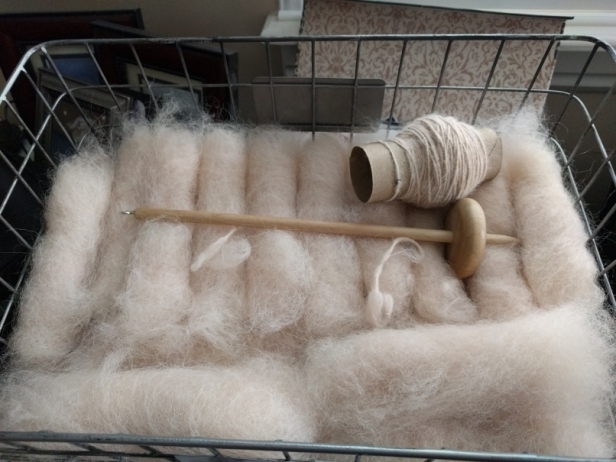
After carding the alpaca fibers it is time to spin the rolags.(from the scottish gaelic word roleags.) Hmm… “spining the rolags” sounds kind of cool… almost street. I might not have to lie to my co-workers Monday when they ask me what I did this weekend. I can just look at them and say… spun some rolags.. add a wink and then say how about you. And as long as they don’t google it or ask me what it means I might pull off some fake street cred.
Back to the point… I didn’t know that small rolls of fiber were called rolags until I was left a great comment from a “real” fiber artist – Leonor. She also mentioned that I should try to keep the softness by doing a “woolen spun as opposed to worsted spun”… (after looking up “rolags” I had to look up woolen versus worsted… I feel like such a novice… from what I learned it is easy to tell the difference between the two… if it is woolen spun you can break the yarn with your hands.)
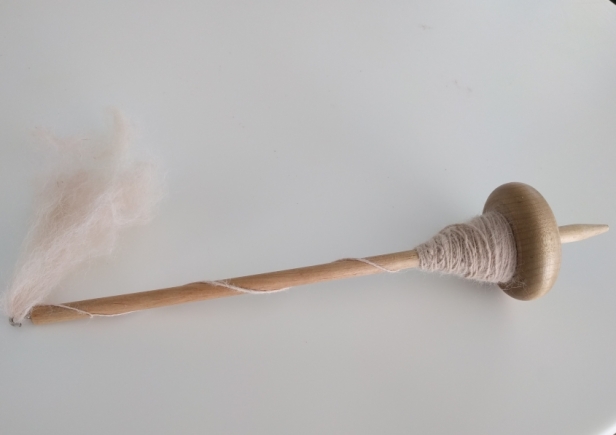
I watched several videos on YouTube but was not able to really catch on… actually I kind of understood but am not talented enough to do it. I imagine if NSA is spying on all of my different YouTube and Google Searching they are scratching their heads… I definitely don’t have street cred with them.
I decided to stick with what I know and that is to spin using this “bottom whorl” drop spindle. I don’t think I have outlined a”how to”… so here are the basic steps for spinning with a drop spindle. (describing it is kind of tough)
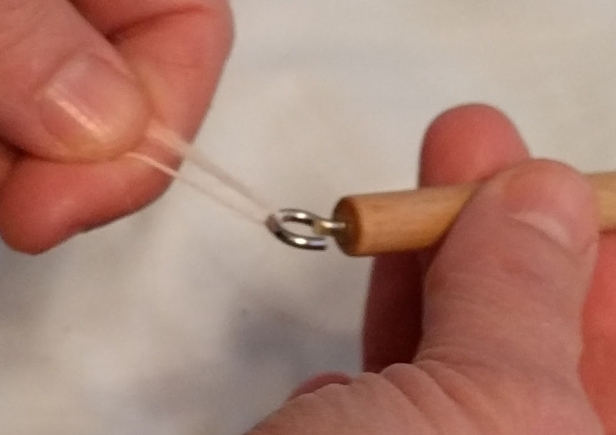
- Pull out fibers and spin into small leader thread… (hand spin clockwise). Create a loop and put loop in the hook. Drop the spindle and start spinning it. This will close the loop. Now you spin the hanging spindle with your right hand and pinch the fibers with your left. You should always spin in one direction… clockwise if you are cool like me.
- When you have a tight spin you stop spinning and move your right hand just under your left hand and pinch the thread. With your left hand now replaced by your right you pull at the un-spun fibers stretching and thinning them out to a consistent amount. This is called drafting and it takes practice. I learned that you have to gently pull and the distance between your right hand and left depends upon the length of the fibers.
- Once you have drafted it to the right thinness pinch at the top of the draft with your left hand and let go of the right hand. The spin in the thread below will travel up the newly “drafted” fiber twisting it up to your left hand. I repeat the process over and over… kind of inch worming and “draftin” through the un-spun fiber. I often will “park” the spindle in between drafting. Parking is putting the drop spindle between your knees or feet and not letting it undo the twist in the fibers. When you park you need to make sure you keep tension on the twisted fibers.
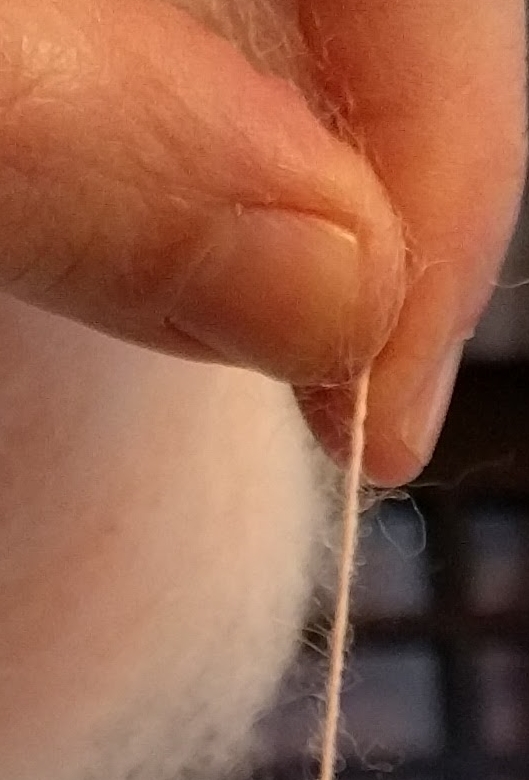
- Once you have a couple of feet you unhook the twisted fibers and tie them at the base of the spindle this is where all of the yarn will be stored as you are spinning. You almost have to see this to understand and I recommend watching this video on YouTube: (this is the first one I watched)
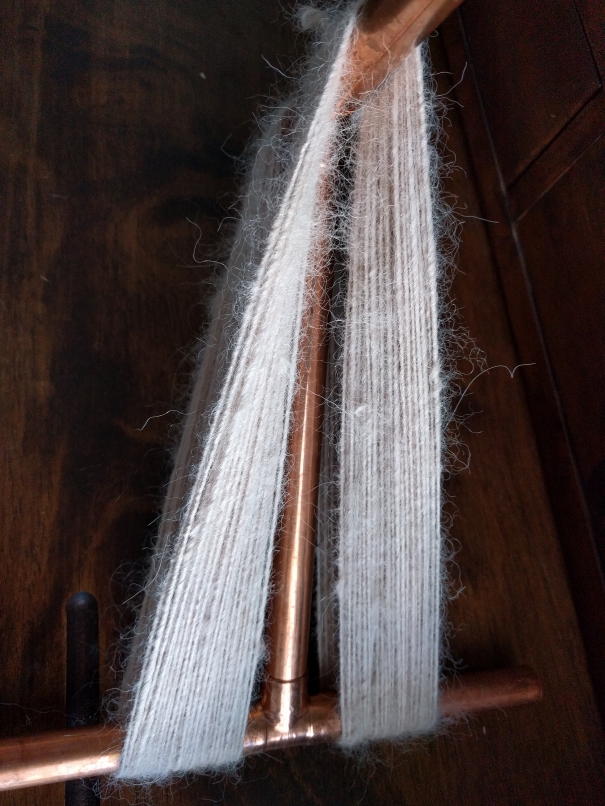
Once I have spun enough.. (this is really and arbitrary decision) I put the single thread yarn on this copper tube niddy noddy that I built. (The first time I heard someway say niddy noddy I thought they were making it up… who is coming up with all of these weird words.) In the past I didn’t do this and I found that the thread had so much kinetic energy that it would twist and knot up on itself… it was very difficult to work with…. when it is washed and dried this way it sets the spin and evens out the twist. The yarn will be calm and well behaved now. (I wished there was something to take the “kinetic” energy out of my kids… )
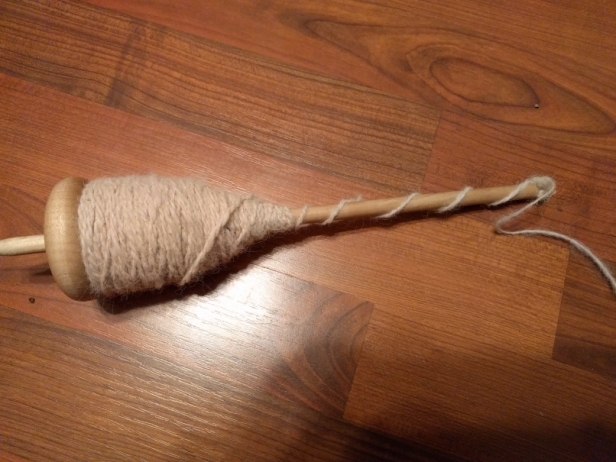
The next step is to ply the yarn. This means twisting several single yarns together. I have never done more than two and I use the same drop spindle. This is very simple. You spin the two yarns together in the opposite direction of what they were spun. (Counter clockwise) I inch up the two singles almost in the same way that I do when making a single but instead of drafting I make sure they two singles are tight and not twisted… I then wash this on the niddy noddy let it dry and then twist it into a skein.
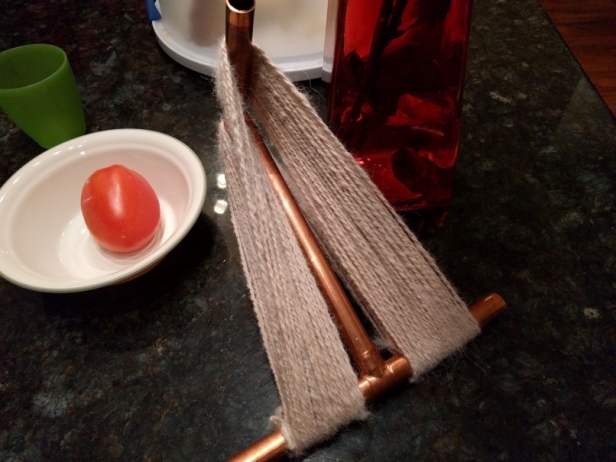
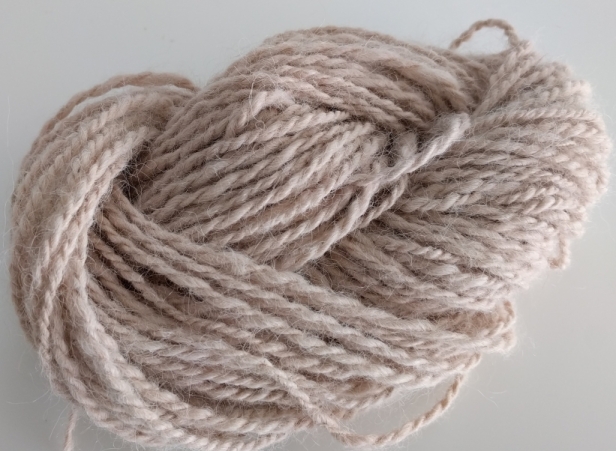
Here is the first skein of Inky Dinky Yarn… died pink from avocado pits. I like this color but it is really a “dusty” pink. I decided to try to get a “pink-ier” pink… and since my wine was a big flop wondered if I could use it to dye some fibers. ( Wine Making (Final) … kind of an expensive dye… ) I am going to make some Inky Drinky Do yarn.
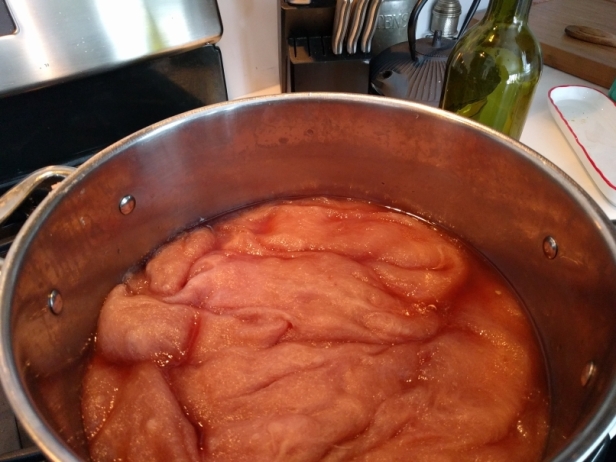
I followed the same process as the avocado dye but added vinegar to the wine to make it acidic and had to follow the dyeing with several rinses since the wine had sugar. I then carded,, spun and 2-plie some of the “pink-ier” yarn with the avocado yarn. (Here are the pictures)
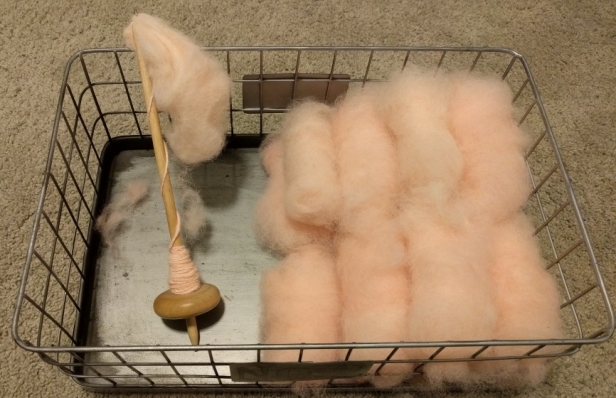
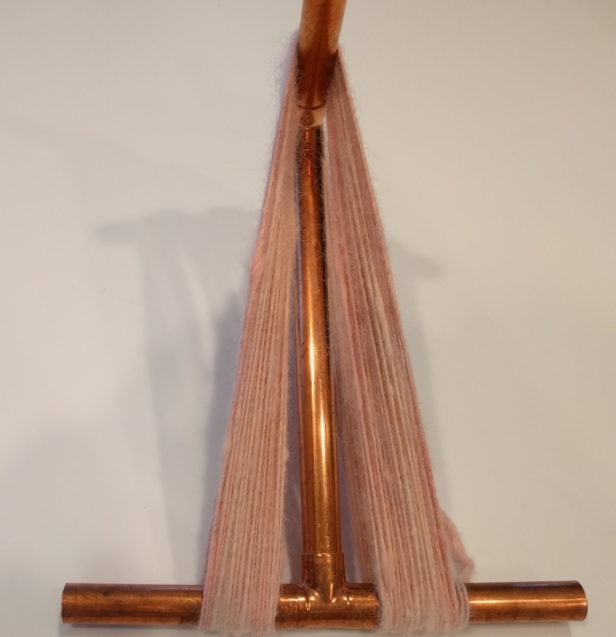
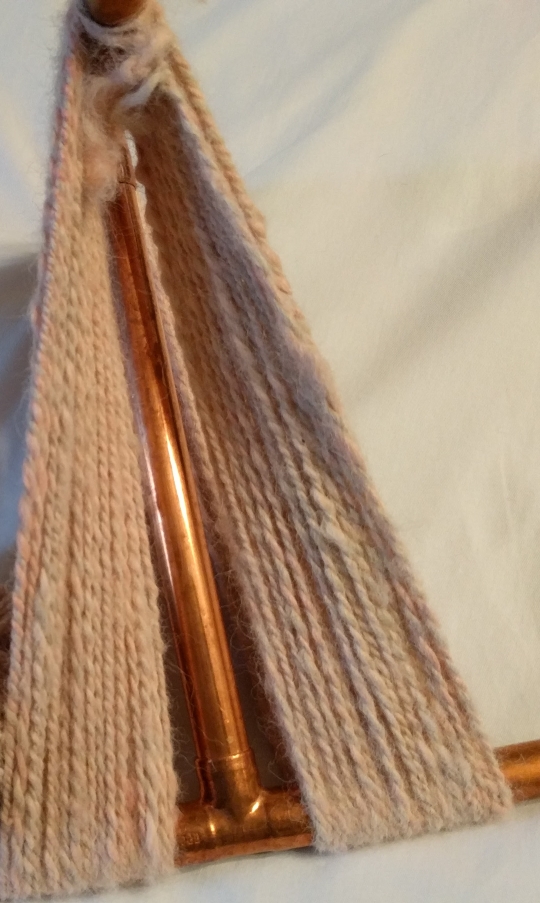
I now have two skeins of about 45 yards (I know they are small… no mocking please). I will continue until I have enough to make something… not sure what… yet… but Isabelle has been teaching me to knit so I imagine I am going to knit something. (I think I just lost more street cred).


This is great. Our students always saw this demonstrated (with a drop spindle) when we visited a working pioneer museum. I did not know people were doing this themselves. Very Cool!
LikeLiked by 2 people
Thank you… There are many people who still do this… as odd as that sounds. There is something really fulfilling in re-visiting old crafts (just takes lots of patience)
LikeLiked by 1 person
wow
LikeLike
You are a renaissance man! Imagine dyeing alpaca fiber with wine and then spinning it into yarn. That is cool!
The wine pink is very pretty. I look forward to following your progress to finished item:)
LikeLiked by 2 people
Thank you… (wished I could knit like you…)
LikeLiked by 1 person
He’s an absolute antique, but (as they say) priceless 🤣
LikeLiked by 2 people
antique… now I feel really old!… hmm… wait, I think the rule of thumb on labelling something antique is that it must be over 100 years old… I am not quite there… so you may be more correct in stating that I am “vintage”…
LikeLiked by 1 person
Wow I’ve been caught out on my use of words. Would you prefer to be a $2 vintage or price antique though?? 😉
LikeLiked by 1 person
$2 is cheap even for me (although some may argue that $2 is way to much)… umm how about “Retro”? or “Collectable”?
LikeLiked by 1 person
Well done! I always admire people willing to spindle spin. I myself went straight for the wheel and I can honestly say I think I’d have killed my mojo if I had to try spindling…
If you’re still looking for instructions on the difference between woollen and worsted spinning, Craftsy has some spindle classes that I’m sure will teach that. I’m not sponsored by them, I just like them (thought I’d clear that up). I have all of Jacey Boggs’s spinning lessons (those are amazing, and she has one called From Worsted to Woollen but they’re for wheels).
If you’re not a Craftsy member yet, create an account and wait for a while; they’ll send you a discount code to use in any lesson you’d like and you save a bit. They also seem to have a full refund policy if you’re not happy with your class, so I think it’s a good way to start 🙂
And thanks for the kind words, I always blush a little when you praise my work, it’s like I actually know what I’m doing or something 😀
LikeLiked by 1 person
PS – Forgot to ask: are you drying your yarn on the Niddy Noddy? If so, you’re tensioning it, which means it’ll look really nice and straight, but once you wet it it might bounce back (it definitely will with wool, not so sure about alpaca) – this means that if you knit a scarf, for example, it can look all straight and nice but once washed it’ll be completely different because it went back to its high twist and tension state. I hope this helps!
LikeLike
ok… so I am doing that… another novice mistake… how should I undo that?… Should I wash it again and then let it dry hanging?
LikeLike
It’s not a mistake! It’s just a way to get a certain result. The amazing Lexi Boeger (also known as Jazz Turtle) does this with her art yarns and they’re something incredible to behold.
I’d say, since you’re all about experimenting, do soak it again and let it dry unweighed, and see what happens. If it’s too twisted after it’s been prepared for drying, it’s a sign you might need to add less twist next time you spin. My yarns usually look really active and over twisted before soaking and twacking but after I’ve done that they hang straight. Wool is magic! 🙂
But bear in mind, I’m really not sure how it works with alpaca, since it’s a fibre structurally different from wool. Go forth and experiment, that’s what we’re here for!
LikeLiked by 1 person
Thanks!!!
LikeLiked by 1 person
Thank you so much… I have always appreciated your advice. I will look into the lessons. (I am almost ready to start trying to felt something… will really appreciate your advice once I have started that)
LikeLiked by 1 person
I’ll be more than happy to help 🙂
LikeLiked by 1 person
Nothing wrong with a small skein of yarn, so long as you have enough skeins for your project (knitted, crocheted or woven). If you really want to make your head spin, try Navajo plying on the drop spindle. It’s a three ply that you create from your initial single AS YOU SPIN IT! I’ve done Navajo ply on both the wheel and the drop spindle and I actually find it easier to do on the spindle… perhaps because that is how I first learned it. It’s sort of like crocheting and spinning at the same time.
LikeLiked by 2 people
Wow… I will have to look into this. (more YouTube Searching). Thank you very much!
LikeLike
Street cred….hahahaha….your sense of humour and engaging writing is as much a gift as your adventurous and uniquely fascinating zest for life 🙂 You are so generous to share all that you do…you brighten my world…thanks for sharing 🙂
LikeLike
I missed this, but now I have found it. I am sure there is a special naming committee. Is it wrong to want to dye Inky Dinky Do herself a lovely pink colour? Do you have enough home-made wine? You have done such an amazing job – I had no idea so much was involved to get wool/yarn/whatever …. I am sure I am using the wrong words 🙂
LikeLiked by 1 person